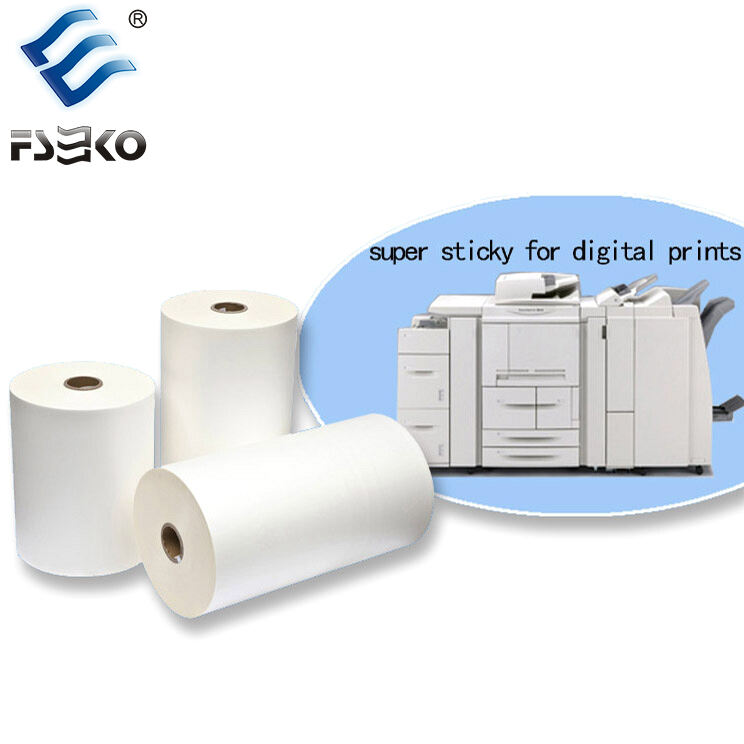Enhanced Durability and Mechanical Protection
Increased durability and lifespan of prints using strong adhesive lamination film
Using strong adhesive lamination film can triple the life of printed stuff when compared to regular non-laminated versions. What makes this possible is that the film sticks really well to whatever surface it's applied to, so there's no peeling off even after lots of handling over time. The special way these polymers are linked together gives extra strength too. Research into similar materials has shown improvements between 20% and 35% in real world settings, which means stuff stays intact much longer than expected.
Resistance to scuffing, smudging, and environmental factors in laminated materials
Laminated surfaces show 97% fewer visible abrasions after standardized scratch testing (ASTM D1044). The chemical-resistant outer layer protects against humidity, ozone, and airborne contaminants, maintaining performance in extreme temperatures from -40°C to 120°C.
Enhanced strength and durability of laminated materials under mechanical stress
Laminated materials exhibit 5X higher puncture resistance (40 N/mm²) and 8X greater tear resistance than unprotected substrates. This is due to the film’s ability to redistribute mechanical stress across the surface through its cross-linked polymer network.
Laminated film thickness and structural integrity for long-term performance
Optimal film thickness (25–250 μm) balances flexibility with protection. Thicker films (≥150 μm) reduce crack propagation by 62% in fatigue tests while maintaining less than 2% elongation under load, making them ideal for high-friction uses such as industrial labels and machinery overlays.
Recent advancements in epoxy nanocomposites demonstrate how innovations in adhesive film formulations can achieve up to 50% higher peel strength than traditional options, further enhancing mechanical performance.
Superior Print and Design Preservation
Preservation of color vibrancy and print clarity through strong adhesive lamination film
Lamination films with strong adhesives can block around 99 percent of harmful UV rays, which helps prevent colors from fading when signs or packages sit outside for long periods. According to industry testing referenced in Print Media Preservation Studies, printed materials protected by these films keep about 94% of their original vibrant colors even after being exposed to sunlight for 18 whole months. That's pretty impressive when compared to regular unprotected prints that only maintain roughly 62% color integrity over the same time frame. The optical clarity is also something worth noting since most quality films allow more than 92% of light to pass through them while forming very little haze (less than 1.5%) even when humidity levels get high. This means text and images stay clear and easy to read no matter what conditions they face outdoors.
Protection of ink and design elements from abrasion and chemical exposure
Adhesive films today cut down on surface wear by around 83% when tested using Taber methods against regular coatings. What this means is that these films create a strong protective layer that stops ink from fading even after lots of touch and go situations. Think about those product labels that get scanned at checkout counters fifty plus times every single day! Plus they stand up pretty well against all sorts of stuff like greasy fingers, harsh cleaners, damp conditions, and the constant bumping around during transport. When it comes to laminated packaging, tests show that the printed information stays intact even after sitting submerged for three whole days in liquids ranging from very acidic (pH 3) to quite alkaline (pH 11). That kind of durability makes them ideal choices for things like drink bottles where labels need to stay readable through all sorts of mishaps, not just in breweries but also in labs storing chemicals safely.
Barrier Performance Against Moisture, UV, and Chemicals
Moisture Resistance in Packaging Applications Using Strong Adhesive Lamination Film
Lamination films with strong adhesives create barriers that stop most moisture from getting through. When we look at how food packages are built, those combining PET and PE layers cut down on water vapor passing through by almost 98%, way better than just using one layer alone. For things like medicines that need very dry conditions under 5% humidity or electronic components that corrode easily when exposed to dampness, this kind of protection really matters. According to industry data from PDA in their 2022 report, these findings hold true across multiple applications where maintaining specific environmental controls is critical.
UV Resistance and Prevention of Print Degradation Under Sunlight Exposure
UV-stabilized films block 99.9% of UV rays (280–400 nm), preventing discoloration and material breakdown in outdoor environments. Unlike standard coatings that yellow within six months, laminated materials retain 90% of their original gloss after 18 months in subtropical climates, as verified by ASTM G154 accelerated weathering tests (2023).
Chemical Resistance and Compatibility With Aggressive Substances
A 2022 material compatibility study found that strong adhesive films resist more than 250 chemicals, including 50% sulfuric acid and common industrial solvents. These films maintain adhesion and structural integrity during 12-month storage cycles, enabling safe containment of automotive fluids and agricultural chemicals.
Improved Environmental Resistance Across Industrial and Outdoor Applications
Laminated films combine protection against moisture, UV exposure, and chemicals, which means they last about five times longer than regular uncoated materials when put through tough conditions. Think about those labels on offshore equipment that get blasted by salt spray day after day, or the markings inside car engines where heat and oil are constant threats. Even cold chain packaging that faces extreme temperature changes between -30 degrees Celsius and +60 degrees Celsius benefits greatly from this protection. According to Packaging Digest from last year, companies using these multi-layered films see their replacement costs drop by around 23% annually across various industrial applications. That kind of savings adds up over time for manufacturers dealing with harsh environments.
Versatile Compatibility with Substrates and Printing Methods
Strong adhesive lamination film demonstrates exceptional adaptability across diverse substrates and printing processes, allowing manufacturers to meet complex functional and aesthetic requirements efficiently.
Substrate compatibility in lamination (e.g., PET, PE, aluminum foil)
The film adheres reliably to polyethylene (PE), polypropylene, polyester (PET), aluminum foil, and paper-based materials without compromising bond strength. This broad compatibility supports unified lamination workflows across mixed-material assemblies. For example, aluminum foil-PET hybrids used in snack packaging maintain 98% barrier efficiency post-lamination, according to 2023 flexible packaging trials.
Integration with digital, offset, and flexographic printing processes
Traditional laminates need long curing times, but with these strong adhesive films, printing shops can apply them right after printing on digital UV, offset, and flexo systems. No more worrying about smudged ink or inconsistent finishes either. We're talking about gloss variations under 8 degrees most of the time. What really matters though is how well the pressure sensitive adhesive sticks to those textured UV cured inks. It just flows right over them without leaving any air pockets behind. This makes all the difference when producing labels with fine details where every little gap counts against quality standards.
Adhesive films in plastic lamination and multi-material assemblies
Cross linked polymers create strong bonds between different materials such as polyester films and metal coated surfaces. When used industrially, adhesive layers around 250 microns thick show significantly better performance compared to traditional solvent based options. Tests indicate these adhesives can achieve roughly 35 percent improvement in peel strength when connecting polyethylene to PVC materials. The enhanced bonding properties are particularly valuable for creating those complex multi layer barriers needed in medical packaging applications. Retail labels that need to resist moisture also benefit greatly from this technology since it reduces the risk of layers separating during normal handling and transportation processes across various supply chains.
Critical Applications in Packaging, Labels, and Healthcare
Benefits of Strong Adhesive Lamination Film in Flexible Packaging and Labeling
Flexible packaging relies heavily on strong adhesive lamination films to keep products fresh longer while stopping those pesky leaks and contaminations we all dread. The multi layer design actually holds up pretty well against rough handling and big temperature swings, which matters a lot when dealing with frozen goods sitting in warehouses or products stored outside during extreme weather conditions. When it comes to labels, these films serve as protective shields for important details like expiration dates and those crucial barcode numbers that make inventory management possible. Logistics companies have noticed something interesting too - around 84% say they spend less money replacing damaged labels since making the switch to laminated options. Makes sense really, since protecting that printed info saves time and headaches down the line.
Role in Healthcare Packaging: Sterile Barrier Performance and Regulatory Compliance
For pharmaceuticals and medical devices, these special films create sterile barriers that meet ISO 11607-1 standards. The main job is stopping microbes from getting in, and they work well with common sterilization techniques including gamma irradiation. Recent research from 2023 found that when using medical grade laminated films, there was around a 62% drop in packaging failures specifically for things like pre filled syringes and surgical instrument kits. What makes them particularly useful is their ability to work with materials similar to Tyvek, which helps manufacturers stay within both FDA 21 CFR Part 11 guidelines and EU Annex 1 requirements for those tamper evident packages that are so critical in healthcare settings.
Resistance to Sterilization Methods (e.g., EtO) in Medical-Grade Laminated Films
Medical laminates keep their stickiness even after being exposed to ethylene oxide sterilization at around 55 degrees Celsius with 60 percent humidity levels. This property is really important when it comes to packaging things meant to go inside the body. Some newer versions of these materials can stand up against damage caused by peroxide plasma treatment as well as regular steam sterilization methods. After going through all that, they still manage to hold together with a peel strength of over 8 Newtons per 15 millimeters. The fact that these materials don't fall apart makes them perfect for making sure home care diagnostic kits stay intact despite constant touching and multiple rounds of intense sterilization required by healthcare standards today.
FAQ
What is the main advantage of using strong adhesive laminated films?
The main advantage is enhanced durability and mechanical protection, providing a longer lifespan for printed materials and resistance to environmental stressors.
How do adhesive films affect print and design preservation?
Adhesive films help preserve color vibrancy and clarity by blocking UV rays and providing a protective layer against abrasion and chemical exposure.
Which substances can laminated films resist effectively?
Laminated films are resistant to moisture, UV rays, and numerous chemicals, making them suitable for industrial applications.
Why are laminated films important in healthcare packaging?
They provide sterile barriers and meet regulatory compliance, ensuring the safety and integrity of sensitive medical products.
Table of Contents
-
Enhanced Durability and Mechanical Protection
- Increased durability and lifespan of prints using strong adhesive lamination film
- Resistance to scuffing, smudging, and environmental factors in laminated materials
- Enhanced strength and durability of laminated materials under mechanical stress
- Laminated film thickness and structural integrity for long-term performance
- Superior Print and Design Preservation
- Barrier Performance Against Moisture, UV, and Chemicals
- Versatile Compatibility with Substrates and Printing Methods
- Critical Applications in Packaging, Labels, and Healthcare
- FAQ


